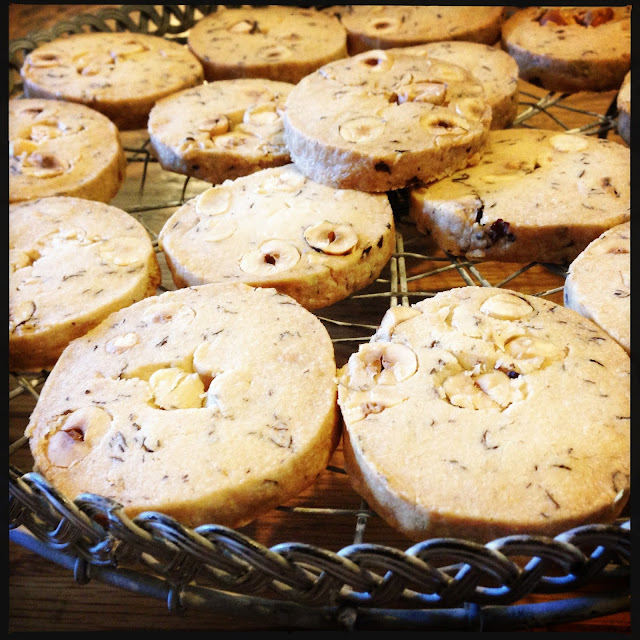In Italy, the production of food is often down to a number of people, family, friends, all happily together rolling out pasta and forming age old shapes. At least this is the picture we have here in the UK where cookery programmes are always available to view on television.
I enjoy the rather solitary nature of cooking, but cooking with my daughter or friends is always a treat and never more so than when making tortelloni, where the tasks of rolling out the dough, cutting out discs, stuffing, folding and sealing the pasta can be shared. Even for novices, the skills are soon learned and there is always a deal of accompanying laughter.
The upshot is everyone enjoying the dish, is made aware of just how much longer it takes to produce a dish of hot plump pasta shapes, slipping around in an unctuous sauce, than it does to eat it. . . . . .
I have for a while now wanted to incorporate the fresh seeds of my fennel plants, growing in the flower beds and so this sauce and stuffing seemed to be a good opportunity.
For the stuffing you will need;
250g of feta cheese, crumbled
100g of parmesan cheese, finely grated
1 egg
1 teaspoon of fresh fennel seeds, chopped
a good pinch of nutmeg
For the sauce you will need;
1 medium size onion, finely chopped
3 cloves of garlic, finely chopped
4 large tomatoes, skinned, de-seeded and chopped
2 teaspoons of fresh fennel seeds, chopped
1 tablespoon of chopped fresh parsley
1 tablespoon of chopped fresh basil
2 sprigs of fresh thyme
2 tablespoons of olive oil
1 tablespoon of creme fraiche
1 tablespoon of Noilly Prat (extra dry vermouth)
1/2 teaspoon of black pepper
1/4 teaspoon of cayenne pepper
For the pasta you will need;
300g of 00 pasta flour (if you don't have any, strong bread flour can be used)
3 large eggs
1/2 teaspoon of salt
Make the pasta by mixing all the ingredients in a food processor, or food mixer fitted with a dough hook or simply by hand. The dough should be kneaded for a few minutes to form a good cohesive mass, I find a good test is to pinch a piece and it should have the same consistency as your earlobe. Set the pasta to one side, wrapped in plastic wrap while you make the stuffing.
Make the stuffing by mixing together the ingredients and forming a soft mix. I sometime use ricotta cheese but I think the use of feta works well, just remember the salt content of both the feta and parmesan is high enough to make the addition of any more salt unnecessary. Place the stuffing mix in the fridge to firm up.
Make the sauce by gently frying the onion and garlic in the olive oil on a medium heat until the garlic begins to take on a little colour and the onion becomes translucent. Add the vermouth and cook for a further minute or two, add the tomatoes and the fennel seeds along with the other herbs, reduce the heat to low, cover and cook for 10 minutes. Remove the thyme stalks, by now the leaves will have come apart from the stalks and become part of the sauce, add the creme fraiche and switch off the heat.
Make the tortelloni by rolling the pasta, using a pasta machine to the thinnest setting. I find if you roll the pasta (a quarter of this recipe at a time) through the thickest setting a few times, folding in between each rolling, until you hear a popping sound as the bubble trapped in the fold is burst, it makes sure the pasta is well enough worked to continue rolling on an ever decreasing setting. Roll out to the thinnest setting and on a large area dusted with fine semolina, lay the pasta down and cut out disc shapes around 8cm diameter. place a small teaspoon of the stuffing in the centre of each disc and close to form a semi-circle pasty shape. Bring both pointed ends together and pinch to form the finished shape. Set aside on a well semolina dusted tray until all are ready to be boiled for 2 minutes in vigorously boiling water.
Bring the sauce up to the boil, adding a tablespoon or two of the pasta cooking liquid to rehydrate. Drain the pasta and serve with the sauce and a scattering of freshly grated parmesan cheese.
Notes:
It is vital that the stuffing is completely sealed in the pasta, squeeze down well to bond both edges together and try to exclude as much air as possible to avoid creating air bubbles.
















































